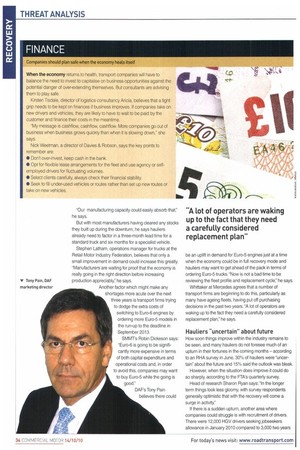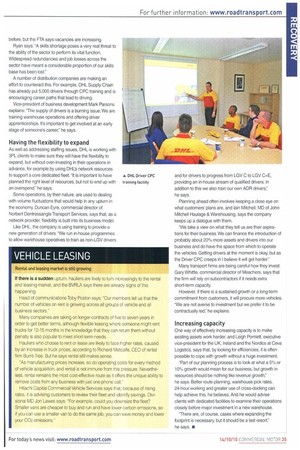Our manufacturing capacity could easily absorb that:' he says.
Page 34

Page 35

If you've noticed an error in this article please click here to report it so we can fix it.
But with most manufacturers having cleared any stocks they built up during the downturn, he says hauliers already need to factor in a three-month lead time for a standard truck and six months for a specialist vehicle.
Stephen Latham, operations manager for trucks at the Retail Motor Industry Federation, believes that only a small improvement in demand could increase this greatly. "Manufacturers are waiting for proof that the economy is really going in the right direction before increasing production appreciably," he says.
Another factor which might make any shortages more acute over the next three years is transport firms trying to dodge the extra costs of switching to Euro-6 engines by ordering more Euro-5 models in the run-up to the deadline in September 2013.
SMMTs Robin Dickeson says: "Euro-6 is going to be significantly more expensive in terms of both capital expenditure and operational costs and, in order to avoid this, companies may want to buy Euro-5 while the going is good."
DAF's Tony Pain believes there could be an uplift in demand for Euro-5 engines just at a time when the economy could be in full recovery mode and hauliers may want to get ahead of the pack in terms of ordering Euro-5 trucks. "Now is not a bad time to be reviewing the fleet profile and replacement cycle:' he says.
Whittaker at Mercedes agrees that a number of transport firms are beginning to do this, particularly as many have ageing fleets, having put off purchasing decisions in the past two years. "A lot of operators are waking up to the fact they need a carefully considered replacement plan:' he says.
Hauliers "uncertain" about future
How soon things improve within the industry remains to be seen, and many hauliers do not foresee much of an upturn in their fortunes in the coming months — according to an RHA survey in June, 30% of hauliers were "uncertain" about the future and 15% said the outlook was bleak.
However, when the situation does improve it could do so sharply, according to the FTA's quarterly survey.
Head of research Sharon Ryan says: "In the longer term things look less gloomy, with survey respondents generally optimistic that with the recovery will come a surge in activity."
If there is a sudden upturn, another area where companies could struggle is with recruitment of drivers. There were 12,000 HGV drivers seeking jobseekers allowance in January 2010 compared to 3,000 two years before, but the FTA says vacancies are increasing.
Ryan says: "A skills shortage poses a very real threat to the ability of the sector to perform its vital function. Widespread redundancies and job losses across the sector have meant a considerable proportion of our skills base has been lost:' A number of distribution companies are making an effort to counteract this. For example, DHL Supply Chain has already put 5,000 drivers through CPC training and is encouraging career paths that lead to driving.
Vice-president of business development Mark Parsons explains: The supply of drivers is a burning issue. We are training warehouse operations and offering driver apprenticeships. It's important to get involved at an early stage of someone's career:: he says.
Having the flexibility to expand
As well as addressing staffing issues, DHL is working with 3PL clients to make sure they will have the flexibility to expand, but without over-investing in their operations in advance, for example by using DH12.s network resources to support a core dedicated fleet. "It is important to have planned the right level of resources, but not to end up with an overspend." he says.
Some operations, by their nature, are used to dealing with volume fluctuations that would help in any upturn in the economy. Duncan Eyre, commercial director of Norbert Dentressangle Transport Services, says that, as a network provider, flexibility is built into its business model.
Like DHL, the company is using training to provide a new generation of drivers. "We run in-house programmes to allow warehouse operatives to train as non-LGV drivers and for drivers to progress from WV C to LGV C+E, providing an in-house stream of qualified drivers. In addition to this we also train our own ADR drivers," he says.
Planning ahead often involves keeping a close eye on what customers plans are, and lain Mitchell, MD of John Mitchell Haulage & Warehousing, says the company keeps up a dialogue with them.
'We take a view on what they tell us are their aspirations for their business. We can finance the introduction of probably about 20% more assets and drivers into our business and do have the space from which to operate the vehicles. Getting drivers at the moment is okay, but as the Driver CPC creeps in I believe it will get harder Many transport firms are being careful how they invest. Gary Whittle, commercial director of Meachers, says that the firm will rely on subcontractors if it needs extra short-term capacity.
However, if there is a sustained growth or a long-term commitment from customers, it will procure more vehicles. 'We are not averse to investment but we prefer it to be contractually led:' he explains.
Increasing capacity
One way of effectively increasing capacity is to make existing assets work harder, and Leigh Pomlett, executive vice-president for the UK, Ireland and the Nordics at Ceva Logistics, says that, by looking for efficiencies, it is often possible to cope with growth without a huge investment.
"Part of our planning process is to look at what a 5% or 10% growth would mean for our business, but growth in resources should be nothing like revenue growth," he says. Better route planning, warehouse pick rates, 24-hour working and greater use of cross-docking can help achieve this, he believes. And he would advise clients with dedicated facilities to examine their operations closely before major investment in a new warehouse.
`There are, of course, cases where expanding the footprint is necessary, but it should be a last resort," he says. •




























































































































